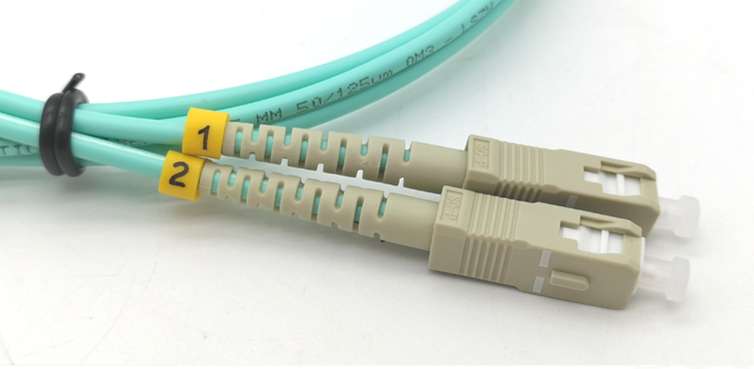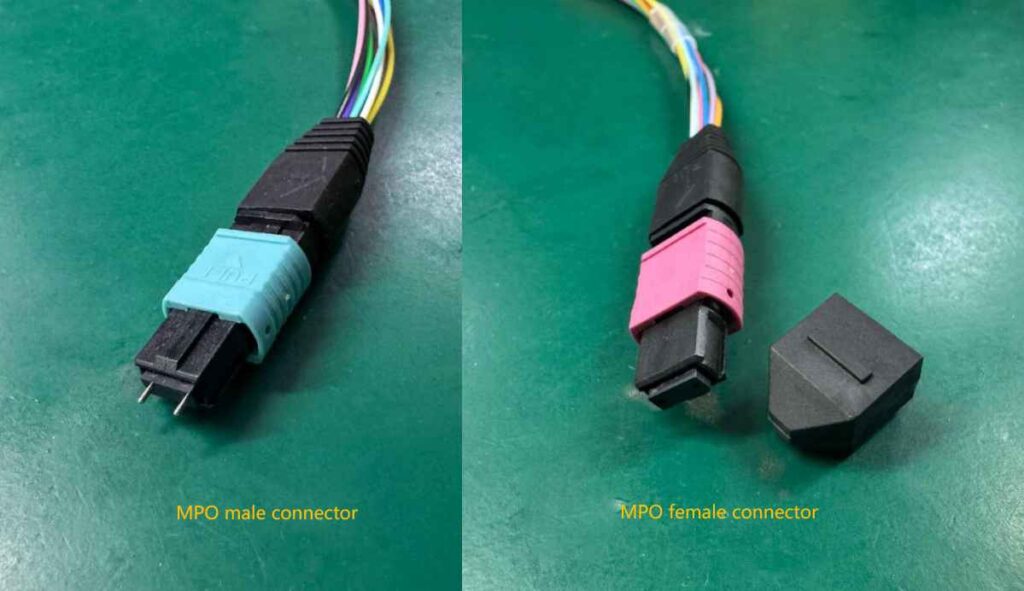Fiber optic connectors are universal passive components. The same type of fiber optic connectors can generally be used in any combination and can be used repeatedly. The additional loss introduced is generally less than 0.2dB.
Below we will give a detailed description of various optical fiber connectors in fiber optic communication networks, and also show you some optical connectors that are rarely exposed to.
According to different classification methods, optical fiber connectors can be divided into different types. According to different transmission media, they can be divided into single mode fiber optic connectors and multimode fiber optic connectors; according to different structures, they can be divided into types of fiber optic connectors such as FC, SC, ST, D4, DIN, Biconic, MU, LC, MT, etc.; according to the ferrule end face of the connector, they can be divided into PC, UPC and APC connectors; according to the number of fiber cores, they can be divided into single core and multi-core connectors. Below we focus on different structure of connectors:
SC Connector

SC type fiber optic connector is an optical fiber connector developed by Japan’s NTT, standard square connector, rectangular shell, made of engineering plastic, has the advantages of high temperature resistance and not easy to oxidize.
The optical interface on the transmission equipment side generally uses SC connector. The structural dimensions of the ferrules and coupling sleeves used are exactly the same as those of the FC type connectors 2.5mm. The end faces of the ferrules mostly use PC or APC grinding methods.
SC fiber connectors fastening method is a plug-and-pull latch type, not require rotation for docking,only need to insert the sc male connector into the coupling, heard “ta” sound, then lock well.
It is low in price, easy to plug and unplug, has small insertion loss fluctuations, high compressive strength, and high installation density.
ST Connector
ST fiber connectors are commonly used in optical fiber distribution frames. The shell is round and the fastening method is a screw buckle. For 10Base-F connections, the connector is usually ST type. Also there are also many media converters that use this ST optical connector

ST interface and SC interfaces are two types of fiber optic connectors. For 10Base-F connections, the connectors are usually ST type. For 100Base-FX, the connectors are mostly SC type. The core of the ST connector is exposed, but the core of the SC connector is inside the connector.
LC Connector
The LC fiber optic connector was developed by the famous Bell Research Institute and is made of an easy-to-operate modular jack (RJ) latch mechanism. The size of the pins and sleeves used is half the size of ordinary SC, FC conectors, which is 1.25mm. It is widely used for high density like fiber optic patch panels in data center or computer room.

At present, in terms of single-mode fiber SMF, LC SC fiber optic connectors have actually occupied a dominant position, and their applications in multi-mode are also growing rapidly.
FC Connector

FC fiber optic connector was first developed by Japan’s NTT. FC is Ferrule Connector, a metal connector, indicating that its external reinforcement method is a metal sleeve, generally used on the ODF side. The metal connector can be plugged and unplugged more times than plastic, and the fastening method is a turnbuckle. At the earliest, the FC type connector used ceramic ferrules for the docking port. FC connector is with simple structure, easy to operate and manufacture.
However, the fiber end face is sensitive to dust and prone to Fresnel reflection, making it difficult to improve return loss performance.
Later, this type of connector was improved by using a PC ferrule with a spherical butt end surface, while the external structure did not change, which greatly improved the insertion loss and return loss performance.
MT-RJ Connector

MT-RJ started from the MT connector developed by NTT. It has the same latch mechanism as the RJ-45 LAN electrical connector. The optical fiber is aligned through the guide pins installed on both sides of the small sleeve. In order to facilitate connection with the optical transceiver, the optical fiber on the connector end face is designed with a dual-core (0.75mm interval) arrangement. It is a next-generation high-density optical fiber connector mainly used for data transmission.
MPO/MTP Connector
The MPO MTP connector is a high-density fiber optic connector that supports more than 2 cores of optical fibers to be integrated into one connector. Currently, MPO-12 connector is commonly used for terminating optical cable connectors in data centers, supporting 40G (12 cores) and 100G (24 cores) fiber optic channels.
MPO/MTP connectors are divided into two types: connectors with guide pins (MPO male connector) and connectors without guide pins (MPO female connector).

MTP connector is an upgraded version of MPO connector, with better transmission performance, lower loss and higher fiber density. MPO/MTP connectors cannot be terminated on site. Even if some manufacturers develop on-site manufacturing processes, they are no longer suitable for large-area use.
BFOC Connector
BFOC connector is an optical fiber interface developed by German Siemens Electric Company for industrial Ethernet equipment. The appearance of the BFOC Connector is very similar to the ST connector, and the buckling method is exactly the same, except that the ceramic core is slightly shorter than the ST connector. It is generally used in industrial Ethernet network equipment, such as industrial switches or microcontrollers (this excuse is widely used in German industrial equipment).

DIN47256 Connector

DIN connector is a connector developed by Germany. The structural dimensions of the pins and coupling sleeves used in this connector are the same as those of the FC type, and the end face treatment adopts PC grinding method. Compared with FC type connectors, its structure is more complex, and there are springs in the internal metal structure that control pressure, which can avoid damaging the end face due to excessive insertion pressure. In addition, this type of connector has high mechanical accuracy, resulting in lower insertion loss values.
FDDI Connector
FDDI connector is mainly used in duplex fiber optic systems. The FDDI backbone network and IEEE802.4 token bus comply with the ansi3t95 FDDI PMD specification.

MU Connector

The MU (Miniature Unit Coupling) connector is developed by NTT based on SC type connector. The connector adopts a 1.25mm diameter sleeve and a self retaining mechanism, which has the advantage of achieving high-density installation. They have socket type connectors (MU-A series) for fiber optic cable connections; Bottom plate connectors with self retaining mechanisms (MU-B series) and simplified sockets for connecting LD/PD modules and plugs (MU-SR series). With the rapid development of fiber optic networks towards larger bandwidth and capacity, and the widespread application of DWDM technology, the demand for MU type connectors will also grow rapidly. The widespread application of WDM technology will also rapidly increase the demand for MU type connectors.
Biconic Connector

The Biconic connector is developed and researched by Bell Laboratories in the United States. It consists of two cylindrical plugs with precision molded ends in a truncated cone shape and a coupling component with a double cone plastic sleeve inside.
SMA Connector

SMA connectors are used in special occasions in fiber optic communication systems. For example, testing equipment, data networks, military instruments, medical equipment, etc. SMA connectors mainly have two different materials of plugs, one is ceramic and the other is metal.
D4 Connector

The D4 connector is a type of old connector with a positioning ring and pressure control spring, which can avoid damaging the end face due to excessive insertion pressure, so the loss of this device is relatively small.. The diameter of the pin is 2.0mm. The main body of the D4 crimping connector is made of brass nickel plated material, and multiple colors of tail sleeves can be selected.
E2000 Connector

The E2000 fiber optic connector adopts a push-pull locking setting, which is easy to install. The housing is made of engineering plastic, which is convenient for dense installation. It is mainly used for single-mode fiber and the joint comes with a dust cover.
OPTI-JACK Connector

The OPTI-JACK fiber optic connector is a type of (SFF) fiber optic connector, which was first used in fiber to desktop applications.
VF45 Connector

VF-45 fiber optic connector, also known as SG (per TIA/EIA-604-7) connector, was introduced by 3M Company in the late 1990s. It can be used for optical signal connection without the need for Ferrule, and is generally preferred for use on the receiving end optical network.
LX5 Connector

LX.5 is a particularly sturdy Small Form Factor (SFF) fiber optic connector designed specifically to meet the on-site needs of the cable television industry.
In the labeling for fiber optic patch cables or fiber optic pigtails, we often see the connector is “FC/PC”, “SC/PC”, the meaning is:
- “/” front: fiber optic connector type – FC, SC
- “/” back: fiber optic connector polishing method – PC
To learn more about fiber end face grinding types, please refer to the article: Optical Fiber End Face Grinding Polishing Method PC UPC APC

